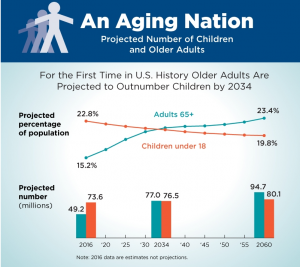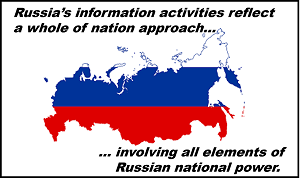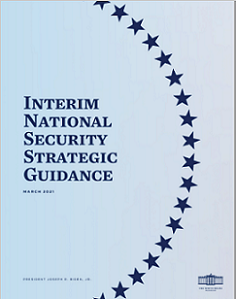[Editor’s Note: Ever since the Reverend Jonathan Swift‘s A Modest Proposal shocked Britain’s 18th century Whig establishment with the suggestion that Irish peasants sell their children as food to help solve that island’s endemic poverty — “A young healthy child well nursed, is, at a year old, a most delicious nourishing and wholesome food, whether stewed, roasted, baked, or boiled; and I make no doubt that it will equally serve in a fricassee, or a ragout” — modern journalistic satire has been used to prick the consciousness of indifferent vested interests into action to address pressing concerns of the day.
Like our adversaries, China and Russia, and indeed, much of the West, the United States has a sizeable aging population. These Boomers (and preceding Silent Generation) have a large claim on the Federal Budget’s mandatory spending (e.g., Social Security and Medicare), squeezing the dollars available for discretionary spending (e.g., Defense). In advocating for “putting ‘Security’ back into “Social Security,’” today’s post by CDR Sean M. Sullivan, JAGC, USN, evokes the Rev. Swift from the other end of the generational spectrum, and proposes employing our budgetarily burdensome Baby Boomers as a digital levée en masse to help the Nation achieve Information Advantage. As a substantial auxiliary force, Boomers can take the fight to the Cognitive Domain as a “cyber militia,” helping us beat back malign foreign influence operations — Read on!]
If You Can’t Eat ‘Em…
It is often said that there are two certainties in life – death and taxes. The reality of today is that while those two certainties remain true, two more are true for Americans: social security is weighed down by a growing elderly population, and the United States is losing influence in the information warfare environment1. As these two seemingly unrelated problems both negatively impact U.S. national security, why not look to leverage one problem to help the other?
 Thus, since you cannot wish for more world influence and you cannot eat the costly elderly population,2 the U.S. needs to look at a new social security requirement that leverages national security value from the growing elderly population. This new mandate should dictate that to receive social security benefits, all recipients must post one “positive” American story or image online, once a month. This will both accelerate American interest and involvement in information warfare and will leverage the untapped resource of the Baby Boomer generation as they begin to weigh down the American budget and [indirectly] negatively impact U.S. national security.
Thus, since you cannot wish for more world influence and you cannot eat the costly elderly population,2 the U.S. needs to look at a new social security requirement that leverages national security value from the growing elderly population. This new mandate should dictate that to receive social security benefits, all recipients must post one “positive” American story or image online, once a month. This will both accelerate American interest and involvement in information warfare and will leverage the untapped resource of the Baby Boomer generation as they begin to weigh down the American budget and [indirectly] negatively impact U.S. national security.
More Strategic Debt

By 2035, about 20 percent of the U.S. population will be over 65 years old, and for the first time in history, they will outnumber the 18 years and under population of Americans.3 Until recently, social security debt ran at a (diminishing) surplus; however, as of 2010, the debt is now at a growing deficit as Baby Boomers age.4 The U.S. currently already spends $939B on social security (i.e., 4.9% of gross domestic product), with an approximate deficit of $66B.5 However, by 2035 there will be approximately 79M Americans eligible for social security benefits, which puts the U.S. on the verge of an additional significant debt deficit of $344B.6 Social security will thus have a 25% shortfall, and the overall debt will be approximately six percent of U.S. gross domestic product.7 Suggestions to make social security more solvent have made no real progress on a viable solution.8 This debt will only get worse as the fiscal implications of COVID manifest in coming years.
Countries that mismanage their resources and continue to generate significant debt are strategically limited in either economic influence and/or  defense spending and are apt to fail.9 Granted the U.S. still outspends its competitors in defense10, the practical impact the looming debt will bring to defense spending and economic incentives remains.11 Therefore, if social security debt is not going to change, then the means to leverage some defense value from social security to offset reductions to existing U.S. defense programs should be examined.
defense spending and are apt to fail.9 Granted the U.S. still outspends its competitors in defense10, the practical impact the looming debt will bring to defense spending and economic incentives remains.11 Therefore, if social security debt is not going to change, then the means to leverage some defense value from social security to offset reductions to existing U.S. defense programs should be examined.
Information Access — “Knowing is Half the Battle”12
Within the U.S., 97% percent of the adult population own cell phones, and 77% have access to online content via smartphones.13 What is of most interest is that of the current 50-64 year old demographic, 83% already have access to the internet via smartphones14 and 64% are using social media and online sources for information and news.15 Those numbers continue to grow annually. U.S. society also gets online at an early age, with 95% of current American teenagers already having online access via smartphones.16 The younger generations are growing up with exposure and access to technology, while older generations are still catching-up.17

It is this growing access to information that has made both American and world audiences so susceptible to influence. Accordingly, states, terrorist groups, and organized crime have taken notice and action.18 The Arab Spring of 2011 demonstrated the power of influence where information access created an opportunity to influence large populations with regional results. While the internet cannot be blamed for the underlying basis for the uprising, it served to influence and mobilize larger audiences.19 Thus, if populations can be influenced to take action through social media and messaging, then there is no limit to the ability to shape and control the battlespace heading into, or while in a kinetic conflict; in essence, to conduct war with information.
Information Warfare — The Other Half of Battle

Information warfare is the ability to control and use information. It is composed of elements like cyber operations, communications, and influence operations.20 Information and persuasion are critical weapons in this realm. This warfare is nothing new, and both China and Russia see information as an effective weapons system. As such, they seek to use information to undermine the legitimacy and benefits of American democracy and society to bolster their own.21 The U.S., nevertheless, still lags in competing in the information realm.22
As a result, U.S. opponents are filling the websites and social media in an effort to undermine U.S. standing and to further their state objectives. This has left uninvolved Americans confused and uncertain about what is or is not real news.23 This also has demonstrated U.S. vulnerability, and thus nations like Russia and China have not only developed information warfare strategies, but have employed “troll farms” to dynamically attack the U.S. online by promoting their messages and images to not only influence Americans, but the rest of the world to form negative perceptions of American ideals.24
The New Cold War of Words
This is not the first time that the U.S. has found itself in a war of ideals and in an information fight targeting the perceptions of the American way of life. During the Cold War, both the U.S. and the Soviet Union recognized the need to influence the people of the world, including domestically. The U.S. found it could better influence the world through the controlled distribution of iconic American products and entertainment as a means to undermine the support of totalitarian and authoritarian regimes. The U.S. had the advantage due to technology, funding, and gross disparities in standards of living; think blue jeans, rock and roll, David Hasselhoff, and McDonald’s. This advantage has eroded.

The primary U.S. organization tasked with spreading American messages was the U.S. Information Agency (USIA), established in 1953.25 USIA’s mandate was to inform and influence foreign audiences by operating the Voice of America (VOA) radio stations, disseminating movies and books, and coordinating world speaker tours.26 USIA then became the Broadcasting Board of Governors (BBG), which operated under the original principles of the Voice of America until 2018.27 The BBG operated until the U.S. Agency for Global Media (USAGM) was created in 2018, “to help constituents better understand the work that the Agency and its networks do.”28 USAGM continued to adhere to the VOA principles and disseminate messages through VOA, and the Radio Free Broadcasting Networks.29 However, a pure governmental organization approach is not enough. How is that failing? The favorable view of individual Americans is in decline. This is presumably based on information and stories online30 showing that favorable views are down to 50% from over 60% a few years ago.31 These views plummeted even more during the Trump administration — especially due to views on how the U.S. handled the COVID-19 pandemic.32 The reality is that the U.S. is losing.
Using National Sticks and Stones
The U.S. has already fallen behind in how it manages domestic and international perception of American ideals in the information environment.33 This is occurring by relegating the spread of American idealism to USAGM, vice utilizing a developed information strategy with a whole of nation approach.34 Further, unlike the U.S., foreign adversaries, in particular, Russia,  have been actively involved in executing their information strategy by leveraging both government and their populations to erode American ideals and favor, both within the U.S. and abroad.35
have been actively involved in executing their information strategy by leveraging both government and their populations to erode American ideals and favor, both within the U.S. and abroad.35
Perhaps as a result of the media storm coming out of the 2016 Presidential elections, where the Russian government allegedly attempted to manipulate U.S. voters,36 the 2017 National Security Strategy of the U.S. recognized that “America’s competitors weaponized information to attack the values and institutions that underpin free societies while shielding themselves from outside information,”37 while U.S. actions have been “tepid” and “fragmented” and lacking strategic focus.38 Thus the strategy directs positive action to influence opinions and interests and further directs that the nation seek to advance American  influence through the dissemination of images and messages that evoke and “Champion American Values” such as freedom, equality, prosperity, and liberty.39 In plain language, there is an imperative to push back against information threats and to take affirmative steps to disseminate American ideals to positively influence the world to again align with the U.S.40 and build allies and partners to counter Chinese and Russian malign behavior.
influence through the dissemination of images and messages that evoke and “Champion American Values” such as freedom, equality, prosperity, and liberty.39 In plain language, there is an imperative to push back against information threats and to take affirmative steps to disseminate American ideals to positively influence the world to again align with the U.S.40 and build allies and partners to counter Chinese and Russian malign behavior.
Recently, the Biden administration published its own Interim National Security Strategic Guidance. Within this strategy document, the President calls for the U.S. to “demonstrate that democracies can still deliver for our people… to defend our democracy, strengthen it and renew it…building back better our economic foundations….[and]  Reclaiming our place in international institutions….[by] Lifting up our values at home and speaking out to defend them around the world….[and by] Revitalizing America’s network of alliances, and the partnerships that have made the world safer for all of our peoples.”41 An active program that leverages average Americans pushing images and information can meet those objectives.
Reclaiming our place in international institutions….[by] Lifting up our values at home and speaking out to defend them around the world….[and by] Revitalizing America’s network of alliances, and the partnerships that have made the world safer for all of our peoples.”41 An active program that leverages average Americans pushing images and information can meet those objectives.
Although the 2017 National Security Strategy calls for increased messaging and the recent 2021 Interim Strategy speaks to renewed efforts domestically and internationally, both are silent on the “how-to” execute. Therefore, another more reliable solution must be found to fill that void from either an existing government program or from another entity willing to cham pion that cause. Social security-eligible Americans can fit the bill and fill the tepid void, and more than double the potential traffic to UASGM websites and social media furthering the express strategic objectives.
pion that cause. Social security-eligible Americans can fit the bill and fill the tepid void, and more than double the potential traffic to UASGM websites and social media furthering the express strategic objectives.
No Really, You Can’t Eat ‘Em
 There are many stereotypes of how people see and treat the elderly American population. Once the free-love-Woodstock-counter-culture-generation, the media now depicts them as living carefree on the fruits of their carefully planned nest eggs while golfing around The Villages retirement community, or as folks free-riding on the backs of the American paycheck. The reality is that nearly nine out of ten Americans over 65 who currently receive social security benefits count on those benefits to provide 90% or more of their retirement income.42 That does not mean that most eligible recipients do not want to work. The opposite is true. Especially of the coming retired generation, 54% express a desire to continue to work after retirement either for more money or to do something fulfilling or what they
There are many stereotypes of how people see and treat the elderly American population. Once the free-love-Woodstock-counter-culture-generation, the media now depicts them as living carefree on the fruits of their carefully planned nest eggs while golfing around The Villages retirement community, or as folks free-riding on the backs of the American paycheck. The reality is that nearly nine out of ten Americans over 65 who currently receive social security benefits count on those benefits to provide 90% or more of their retirement income.42 That does not mean that most eligible recipients do not want to work. The opposite is true. Especially of the coming retired generation, 54% express a desire to continue to work after retirement either for more money or to do something fulfilling or what they  like to do.43 That generation already possesses the tools to combat information warfare: a phone, access to the internet, time, “American” experiences, and motivation to do more; herein lies the opportunity.
like to do.43 That generation already possesses the tools to combat information warfare: a phone, access to the internet, time, “American” experiences, and motivation to do more; herein lies the opportunity.
Weaponizing the Elderly
By creating a social security benefit requirement, the U.S. can conscript an agile and online American information militia.44 In a sense, they can weaponize the American elderly. Through this program, the U.S. will be able to  mobilize the colossal social security generation to assist in combating national security threats through the use of strategic online information campaigns that highlight truthful and “positive” American ideals for both American and foreign consumers; something generally akin to posting “#proudAmericans” or “#Americanideals”.
mobilize the colossal social security generation to assist in combating national security threats through the use of strategic online information campaigns that highlight truthful and “positive” American ideals for both American and foreign consumers; something generally akin to posting “#proudAmericans” or “#Americanideals”.
Some might argue that the conscripted beneficiaries will post negative things or be critical of the U.S. — that is precisely the point! Unlike Russia and China, Americans will be exercising Americanism through their free expression, while creating an information campaign not encumbered by over-staffed and out of date information strategies, or lack thereof. Further, each month the U.S. Government could also provide more specific voluntary themes to dynamically adjust messaging to meet specific emerging threats and information at home and abroad to reassure allies and partners. Simply, the U.S. will be able to leverage a population of over 70 million people to advance American influence through the dissemination of ideal images and messages, good and bad, to evoke and “champion American values”45 in social media. This will provide a means to counter the negative online messages and information being disseminated by American adversaries, as well as enable coordinated action for pushing positive U.S. influence into international opinions and interests.
For those that would counter that adding requirements to social security is a third rail, a program to modify existing benefit requirements in the interest of national security is the best bet for success compared to the current plan of hoping for some great social security compromise. By putting “security” into social security, it becomes more than just a social program. It increases the value from every dollar spent on social security and would inject over 70 million American messages into the world-wide information realm by the actual American people that the world already favors, vice just some U.S. government news agency. The sheer volume to counter negative messages would yield tangible benefits not only to the views of American society and ideals worldwide but presumably domestically as well.
This program, at best, will enable the U.S. to dynamically address information threats as well as offset some future defense costs for information warfare by leveraging the sunk cost and people of social security. At worst, this program will create fierce debates on penalizing the elderly and other potential Constitutional issues, including conscription. In either event, just the suggestion will at least heighten American awareness of the issues of information warfare and social security debt which could lead to new debates, conversations and solutions that demonstrate American ideals of vigorous and free debate, and perhaps inspire some pro-American volunteer participation in the information war. I suppose we could also consider looking to eat the elderly, as Swift suggested, but that isn’t really the point is it?
inspire some pro-American volunteer participation in the information war. I suppose we could also consider looking to eat the elderly, as Swift suggested, but that isn’t really the point is it?
Conclusion — Heading into the Light
With looming social security debt and foreign influence here to stay, challenges, problems and solutions need to be found differently. In the face of dwindling resources caused by increased social security debt, and now COVID, information and influence programs are likely to continue to suffer in more and more constrained budget environments. There is nothing to step into the breach to stem the tide of debt and influence. Current defense budgets focus too much on tactically influencing the world through “[a] more lethal, resilient, and rapidly innovating Joint Force, combined with a robust constellation of allies and partners, [that] will sustain American influence and ensure favorable balances of power that safeguard the free and open international order,” vice a focus on stated strategy for information and influence operations.46 This tactical focus will not change the strategic future to U.S. advantage.
The only chance the U.S. has for getting back into the information fight is by mobilizing U.S. interests in information, influence, and the strategic risks of debt. The U.S. must start to empower a focused culture of American participation in the dissemination of  American ideals and national defense in the information environment and perhaps that will lead to modern walls coming crumbling down at the feet of the next Hasselhoff (who would also qualify under this program – here is your next chance Mr. Hasselhoff!) And perhaps just by suggesting a social security-funded weaponized elderly cyber-militia that would offer “a fair, cheap and easy method of making these [elderly] sound and useful members of the common-wealth”47 — even if this was just to influence and energize Americans to take notice and participate in the information war raging around them and to “Let’s Tweet, Grandma.”
American ideals and national defense in the information environment and perhaps that will lead to modern walls coming crumbling down at the feet of the next Hasselhoff (who would also qualify under this program – here is your next chance Mr. Hasselhoff!) And perhaps just by suggesting a social security-funded weaponized elderly cyber-militia that would offer “a fair, cheap and easy method of making these [elderly] sound and useful members of the common-wealth”47 — even if this was just to influence and energize Americans to take notice and participate in the information war raging around them and to “Let’s Tweet, Grandma.”
If you enjoyed this post, check out the following related content:
The Inexorable Role of Demographics, by proclaimed Mad Scientist Caroline Duckworth
“Tenth Man” — Challenging our Assumptions about the Future Force
China and Russia: Achieving Decision Dominance and Information Advantage and Making the Future More Personal: The Oft-Forgotten Human Driver in Future’s Analysis, by Ian Sullivan
Weaponized Information: What We’ve Learned So Far…, Insights from the Mad Scientist Weaponized Information Series of Virtual Events, and all of this series’ associated content and videos
What the Joint Force can learn from K-Pop “Stans”, by Matthew Ader
Modernize U.S. Auxiliary Forces for New Era of Great Power Conflict, by LTC Steve Speece
The Future of War is Cyber! by CPT Casey Igo and CPT Christian Turley
Sub-threshold Maneuver and the Flanking of U.S. National Security, by Dr. Russell Glenn
Global Entanglement and Multi-Reality Warfare and associated podcast, with COL Stefan Banach (USA-Ret.)
The Erosion of National Will – Implications for the Future Strategist, by Dr. Nick Marsella
Sean M. Sullivan is an officer in the United States Navy and Naval War College graduate.
Disclaimer: The views expressed in this blog post do not necessarily reflect those of the Department of Defense, Department of the Navy, Department of the Army, Army Futures Command (AFC), or Training and Doctrine Command (TRADOC).
1 Derek Bernsen, “War in All but Name”; The Strategy Bridge, April 26, 2021, https://thestrategybridge.org/the-bridge/2021/4/26/war-in-all-but-name
2 For “whoever could find out a fair, cheap and easy method of making these [elderly] sound and useful members of the common-wealth, would deserve so well of the public, as to have his statue set up for a preserver of the nation.” Johnathan Swift, “A Modest Proposal”, http://www.gutenberg.org/files/1080/1080-h/1080-h.htm
3 United States Census Bureau. “An Aging Nation,” https://www.census.gov/content/dam/Census/library/visualizations/2018/comm/pop-projections-1_800.jpg
4 The Heritage Foundation, “Social Security Deficits Are Permanent and Growing,” Heritage Foundation, access February 5, 2019. https://www.heritage.org/sites/default/files/~/media/images/reports/2012/06/ib3638_chart5_750.jpg
5 Ibid.
6 Romina Boccia, “CBO Report Echoes Trustees on Medicare, Social Security,” The Heritage Foundation, June 14, 2012. https://www.heritage.org/budget-and-spending/report/cbo-report-echoes-trustees-medicare-social-security
7 United States Social Security Administration. Goss, Stephen, “The Future Financial Status of the Social Security Program,” Social Security Bulletin, Vol. 70, No. 3, 2010. https://www.ssa.gov/policy/docs/ssb/v70n3/v70n3p111.html
8 Ibid.
9 Paul Kennedy, “The Rise and Fall of the Great Powers”, New York: Random House Vintage Books, 1987, pp. 278-286.
10 This weakening comes into further focus when considering that US peer competitors, China and Russia, have increased defense spending. Since the early 2000’s Russia increased spending and spent between 3.6% and 5.5% GDP, i.e., $66B to $88B, and China reportedly annually spends only 1.9% GDP, which is still $229B. World Bank, “World Development Indicators” Accessed on 5 Feb 2019.
11 Kennedy, pp. 278-286.
12 G.I. Joe, A Real American Hero, Ron Friedman, Marvel and Sunbow Productions, (New York), 1985-1986.
13 “Mobile Fact Sheet.” Pew Research Center, Washington, D.C. (February 5, 2019) http://www.pewinternet.org/fact-sheet/mobile/
14 “Mobile Fact Sheet.” Pew Research Center, Washington, D.C. (April 12, 2021) https://www.pewresearch.org/internet/fact-sheet/mobile/
15 “Social Media Use in 2018.” Pew Research Center, Washington, D.C. (March 1, 2018) http://www.pewinternet.org/2018/03/01/social-media-use-in-2018/
16 “Teens, Social Media and Technology 2018.” Pew Research Center, Washington, D.C. (May 31, 2018) http://www.pewinternet.org/2018/05/31/teens-social-media-technology-2018/
17 To juxtapose with American access, 67% of median world users have access to web-based content and social media via cellphones or desktop based internet. In fact, in the most impoverished regions and countries of the world have a strong and growing foothold to access: 72% of the population in the Middle East has access, 58% in Asia, and 25% in Africa. Internet and smartphones are the growing future source for information in these regions. “Smartphone Ownership and Internet Usage Continues to Climb in Emerging Economies.” Pew Research Center, Washington, D.C. (February 22, 2016) http://www.pewglobal.org/2016/02/22/internet-access-growing-worldwide-but-remains-higher-in-advanced-economies/
18 Dewey, Taylor, et al. “The Impact of Social Media on Social Unrest in the Arab Spring”, Stanford Public Policy, (2012), https://publicpolicy.stanford.edu/publications/impact-social-media-social-unrest-arab-spring
19 Ibid.
20 Rand Waltzman, “The Weaponization of Information: The Need for Cognitive Security,” Testimony to US Senate Armed Services Committee, Washington D.C. April 27, 2017. https://www.armed-services.senate.gov/imo/media/doc/Waltzman_04-27-17.pdf
21 Ibid.
22 Ibid.
23 “Many American Believe Fake News Is Sowing Confusion.” Pew Research Center, Washington, D.C. (December 15, 2016) http://www.journalism.org/2016/12/15/many-americans-believe-fake-news-is-sowing-confusion/
24 Joshua Geltzer, “Stop Calling them ‘Russian troll farms,'” CNN, August 17, 2018, https://www.cnn.com/2018/08/17/opinions/stop-calling-russian-operatives-troll-farms-geltzer/index.html
25 United States National Archives, Foreign Affairs, “Records of the United States Information Agency (RG 306),” Processed January 2017, https://www.archives.gov/research/foreign-policy/related-records/rg-306
26 Matthew Armstrong, “No, We Do Not Need to Revive the U.S. Information Agency,” War On the Rocks, November 12, 2015. https://warontherocks.com/2015/11/no-we-do-not-need-to-revive-the-u-s-information-agency/
27 United States Broadcasting Board of Governors, U.S. Agency for Global Media, accessed on February 5, 2019. https://www.usagm.gov/who-we-are/history/ ; These principles were to “communicate directly with the peoples of the world by radio;” “serve as a consistently reliable and authoritative source of news;” “be accurate, objective, and comprehensive;” “represent America, not any single segment of American society;” and therefore “present a balanced and comprehensive projection of significant American thought and institutions;” and “present the policies of the United States clearly and effectively, and also present responsible discussions and opinions on these policies,” see: Foreign Relations Authorization Act, Fiscal Year 1977. Public Law 94-350 at 90 STAT 831-832. Accessed at: https://www.govinfo.gov/content/pkg/STATUTE-90/pdf/STATUTE-90-Pg823.pdf
28 United States Broadcasting Board of Governors, U.S. Agency for Global Media, accessed on February 5, 2019. https://www.usagm.gov/who-we-are/history/
29 Ibid.
30 “U.S. Image Suffers as Publics Around World Question Trump’s Leadership.” Pew Research Center, Washington, D.C. (June 26, 2017) http://www.pewglobal.org/2017/06/26/u-sg-image-suffers-as-publics-around-world-question-trumps-leadership/
31 “How the world views the U.S. and its president in 9 charts.” Pew Research Center, Washington, D.C. (October 9, 2018) http://www.pewresearch.org/fact-tank/2018/10/09/how-the-world-views-the-u-s-and-its-president-in-9-charts/
32 “U.S. Image Plummets Internationally as Most Say Country Has Handled Coronavirus Badly.” Pew Research Center, Washington, D.C. (September 15, 2020) https://www.pewresearch.org/global/2020/09/15/us-image-plummets-internationally-as-most-say-country-has-handled-coronavirus-badly/
33 Waltzman, “The Weaponization of Information”
34 United States Broadcasting Board of Governors, Mission.
35 Waltzman, “The Weaponization of Information”
36 Christopher Miller, “Facebook Removes Hundreds of Fake Pages, Accounts ‘Linked’ to Russia’s Sputnik”, Radio Free Europe Radio Liberty, January 17, 2019, https://www.rferl.org/a/facebook-removes-hundreds-of-fake-pages-accounts-linked-to-russia-s-sputnik/29715725.html?utm_source=Sailthru&utm_medium=email&utm_campaign=ebb%2018.01.19&utm_term=Editorial%20-%20Early%20Bird%20Brief
37 United States. 2017. The National Security Strategy of the United States of America. Washington: President of the U.S, 34
38 Ibid at 41.
39 Ibid at 35.
40 Ibid at 34.
41 United States. 2021. The Interim National Security Strategy Guidance of the United States of America. Washington: President of the U.S, 23
42 United States Social Security Administration, “Fact Sheet”, accessed February 5, 2019, https://www.ssa.gov/news/press/factsheets/basicfact-alt.pdf
43 Transamerica Center for Retirement Studies, “Wishful Thinking or Within Reach? Three Generations Prepare for ‘Retirement’ 18th Annual Transamerica Retirement Survey of Workers,” December 2017, https://www.transamericacenter.org/docs/default-source/retirement-survey-of-workers/tcrs2017_sr_three-generations_prepare_for_retirement.pdf , 9
44 United States Internal Revenue Service, “Tax Counseling for the Elderly,” November 19, 2018, https://www.irs.gov/individuals/tax-counseling-for-the-elderly
45 United States. 2018. The National Security Strategy of the United States of America.
46 United States, Department of Defense, Office of the Under Secretary of Defense (Comptroller), Chief Financial Officer, “Defense Budget Overview, Fiscal Year 2019 Budget Request,” Revised February 13, 2018, https://comptroller.defense.gov/Portals/45/documents/defbudget/FY2019/FY2019_Budget_Request_Overview_Book.pdf, 1-1
47 Swift. A Modest Proposal.




“Thus, if populations can be influenced to take action through social media and messaging, then there is no limit to the ability to shape and control the battlespace heading into, or while in a kinetic conflict; in essence, to conduct war with information.”
While anecdotal evidence indicates that social media could possibly drive polarization there is no evidence that social action is a result of social media. In fact, most studies indicate that people are content to vent their ire on line and do little else. So far the base assumption in this article has not been proven by any research. There is a huge gap between posting an inflammatory message and actually taking a physical action. Until we better understand how that gap manifests and what kinds of media push people to cross that gap this article this article has little foundation.
Gary, I think you might be on the wrong track here. While I agree with you that there is no real evidence that social ire turns into physical action, the author doesn’t make any assertion that taking up the quill, so to speak, on social media will lead to physically winning a war. In fact, you quote him as saying quite the opposite: “if populations can be influenced to take action through social media and messaging…” No one is asking old people to fight our wars. He is simply asking them to get involved, flood the airwaves with authentically American messages to counter foreign bot messages, and to rouse the people into caring about the level of misinformation they are consuming.
I appreciate you taking the time to so quickly engage in the information domain and to physically type a response to my quasi-inflammatory musings — that was precisely the foundational point of the article…”even if this was just to influence and energize Americans to take notice and participate in the information war raging around them.” Thank you.
I am all for controversial and divergent thinking. BUT, and it is a a big big but and on so many arguments. Just a couple: this piece is riddled with unvalidated and definitely questionable assumptions – for example, the Baby Boomer generation is socialized to be able to distinguish fact from fiction, truth from falsehood, and operate at the higher levels of self-aware, self-evaluative reasoning and thinking. They have not. Please do not confuse being able to tweet with the grandkids, as proof of digital literacy. The Baby Boomer generation grew up with substantially more black and white understandings about where truth could be found and with vastly less exposure to the sort of rabid conspiratorial disinformation attacks they are on the receiving end of today. Their ability to NOT be sucked in, fooled, and to spit back accurate, truthful information in some sort of perpetual online info war is highly questionable.
Second, a civilian militia – this is an oxymoron. Once in a militia, the person is no longer a civilian and no longer retains the same legal rights, protections and privileges as a civilian – let’s check out the Geneva Protocols on illegal combatants. You are treating disinformation campaigns in the same legal, terminology and thinking framework as those of war. Strategic competition with other great powers is not WAR. In this regard, I don’t believe you have been “divergent” enough. You are trying to shoehorn civilians into a military way of looking at this problem. Crowdsourcing – yes, but not a militia.
I could go on, but time is not on my side.
What in this article implies that the Baby Boomers are socialized to be able to distinguish between truth and fiction? I don’t think that’s the premise and I don’t think the author assumes they have some magical power of BS detection (or that being able to tweet makes them IT pros). The point is exactly the “rabid conspiratorial disinformation attacks” you mention. The fact is they (for the most part) have time on their hands and grew up in a culture of getting involved for the greater good (not to mention a deep-seated pro-America, anti-bad guy worldview). Why wouldn’t we try to put those things to good use to flood the airwaves with pro-America messages to counter all the nonsense out there?
Your second point – that a civilian militia is an oxymoron – is flat out incorrect from both an English language and an international legal framework perspective. A militia is, by its very nature, made up of civilians who take up arms. I will grant you that taking up arms will negate their right to be treated as a protected civilian under the GC, but taking to their phones to spread information is HARDLY taking up arms, or even participating in hostilities in any meaningful way. I don’t think the author is taking grandma to war. He is asking her (and grandpa, too!) to participate in the war effort; no different than the entire country participating in the war effort during WWII by giving up luxuries like aluminum and rubber.
Lastly, the fact that you are outraged by so many aspects of this article is, I’m sorry to say, they entire reason for the article’s existence. It is satire. It is meant to ruffle feathers. It got you to pay attention and speak out. Job well done.
And my apologies for a second comment, but I find it hardly respectful to label the baby boomer generation as a now a budgetarily burdensome nuisance that restricts discretionary spending on defense. The baby boomer generation as a generation paid their taxes, paid their social security taxes in exchange for the promise of pensions at their retirement. They are not the responsible party – Congress members who have for decades refused to recognize and respond effectively to the blinding flash of the obvious that the baby boomer generation would be the largest and live longer than any earlier generation. Congress members who have for decades raided the social security accounts purposefully rejecting and ignoring all risk and consequences advice from Federal government advisers. So, the baby boomer generation is not responsible for their size or longevity. When we reach their age, will we be happy with being labelled as an inconvenient and costly burden???
Wow, hit a nerve there. Yes, I am a 75 year baby boomer and I am appalled that our country has been suffering bipolar syndrome for the last 50+ years. This was not anything that was created by most boomers or approved by most boomers.
To the point, we will engage with a very near peer or peer force some time in the next few years. In the case of China, one simply needs to look at their belt and road initiative to see that they operate on a much higher plane of homogeneity than folks in the good old USA. That is millions of people who believe that Xi Jinping is good for all of China as well as all Chinese people. Major issue there. Take a look at Russia and if you have read any of the classical Russian authors such as Gogol, Turgenev, Tolstoy, and Dostoevsky, you will come away with an appreciation of how dedicated they are to the Russian concept of “Nasha Rasha” and the true significance of “Rodina”. Just another example of oneness.
The point being made is that Americans need to somehow acquire that same oneness or our country may be easily placed into the history books. I think we as citizens of this country need to step it up.
Agree completely, Jim! I wish all the 75-year-old baby boomers would get the rest of this country in line (starting first, sadly, with the 75+-year-old baby boomers in our government). The polarization is what will kill us, not the “enemy.” The fact that so many boomers went through so much that required compromise and an attempt to understand others and came out stronger should be a lesson for us all. (Note: No I do not see the world with rose-colored glasses. Clearly there were some tremendously awful things that the boomers and others let slide – like, say, segregation and Jim Crow – but on the whole, your generation has a much better understanding of the perils of division on the global scale.)